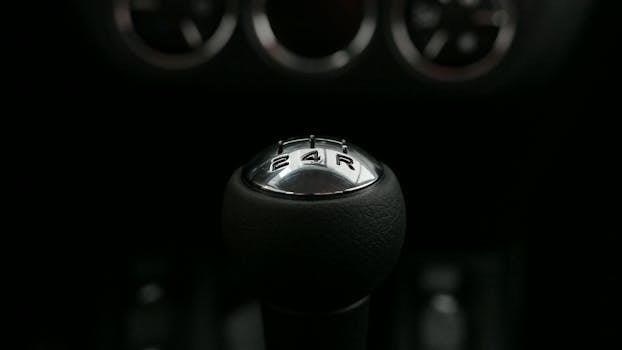Dodge 6-Speed Manual Transmission Overview
The Dodge 6-speed manual transmission is a notable feature in select models, offering drivers enhanced control and engagement. It was prominently used in the Ram 1500 with both the 4.7L and 5.7L V8 engines; This transmission is favored by enthusiasts for its robust design and performance. Dodge continues to provide manual options, highlighting their commitment to diverse driver preferences.
Availability in Dodge Models
Dodge has strategically incorporated the 6-speed manual transmission into specific models to cater to enthusiasts who appreciate a more hands-on driving experience. While automatic transmissions dominate the market, Dodge’s commitment to manual options remains evident. Notably, the 6-speed manual was a prominent feature in the Dodge Ram 1500, particularly when paired with the 4.7L and 5.7L V8 engines, providing drivers with a robust and engaging powertrain setup. This transmission choice allows for greater driver control over gear selection, enhancing the overall driving dynamics of these models. Though less prevalent in current lineups, the presence of the 6-speed manual in models like the Challenger, Dart, and Viper highlights Dodge’s dedication to offering options for individuals who prefer the tactile feedback and connection offered by manual transmissions. The availability of this transmission underscores Dodge’s understanding that some drivers value the control and performance that a manual transmission provides, setting them apart from brands that have moved almost exclusively to automatic options.
Getrag G238 Transmission
The Getrag G238 transmission is a specific model of the 6-speed manual that holds significance within the Dodge lineup. This particular transmission was notably used in the Dodge Ram 1500 trucks, primarily those equipped with the 4.7L and 5.7L V8 engines. Getrag, a well-known transmission manufacturer, designed the G238 to handle the power and torque output of these engines, ensuring reliable performance and durability. Its robust construction is a key factor in its suitability for truck applications, where demanding workloads are common. The inclusion of the Getrag G238 emphasizes Dodge’s commitment to providing quality components for their vehicles, particularly in models where manual gear selection is a crucial aspect for drivers. This transmission is recognized for its smooth shifting and overall reliability, making it a popular choice for those who prefer a manual driving experience in their Dodge trucks. The Getrag G238 stands as a testament to Dodge’s attention to detail in providing a high-quality manual transmission option.
Use in Dodge Ram Trucks
The 6-speed manual transmission has been a notable option in various Dodge Ram truck models, catering to drivers who prefer a more hands-on driving experience. Specifically, the Getrag G238 variant of the 6-speed manual was implemented in Dodge Ram 1500 trucks that featured the 4.7L and 5.7L V8 engines. This highlights Dodge’s commitment to offering a range of transmission choices to meet different driver preferences and needs. The use of the 6-speed manual in these trucks provides a greater sense of control and engagement, which is often favored by those who enjoy the traditional feel of manual gear changes. This transmission option is known for its robustness and dependability, making it a suitable choice for the demanding tasks that Ram trucks are frequently subjected to. This demonstrates Dodge’s attention to detail in providing a high-quality manual transmission option for their truck lineup, ensuring a durable and reliable experience for their customers. Furthermore, the availability of a 6-speed manual in Ram trucks underscores Dodge’s dedication to offering diverse powertrain options.

Dodge Manual Transmission Options
Dodge offers both 5-speed and 6-speed manual transmissions in select models, appealing to drivers who prefer greater control. These options provide a more engaging driving experience compared to automatic transmissions, catering to enthusiasts.
5-Speed vs. 6-Speed Manuals
Dodge has historically offered both 5-speed and 6-speed manual transmissions, each catering to different performance needs and vehicle applications. The 5-speed manuals, often found in older models, provided a more traditional driving experience with fewer gear ratios. These were designed for a balance of fuel efficiency and performance, suitable for everyday driving and light-duty tasks. In contrast, the 6-speed manual transmission offers an additional gear, which can improve acceleration and provide a more refined driving feel, particularly at higher speeds. This extra gear also allows for closer gear ratios, enhancing the overall performance and responsiveness of the vehicle. The 6-speed is frequently paired with more powerful engines, making it a popular choice for performance-oriented models. Ultimately, the choice between a 5-speed and a 6-speed manual depends on the specific vehicle model and the driver’s preferences for performance and driving style. While the 5-speed provides a simpler design, the 6-speed offers enhanced capabilities and a more modern feel.
Manual Transmission in Modern Dodge
In today’s automotive landscape, where automatic transmissions dominate, Dodge continues to stand out by offering manual transmissions in select models. This commitment appeals to enthusiasts who prefer the direct engagement and control that manual transmissions provide. The availability of manual options in models like the Challenger, Dart, and Viper underscores Dodge’s dedication to performance and driver-centric design. This is a notable contrast to many other manufacturers that have largely phased out manual transmissions in favor of automatics and dual-clutch systems. Modern Dodge manual transmissions are engineered for both durability and performance, utilizing advanced materials and designs to enhance the driving experience. They are often paired with powerful engines, allowing drivers to fully explore the vehicle’s performance capabilities. By maintaining this option, Dodge caters to a specific segment of the market that appreciates the unique feel and involvement of a manual transmission. This choice provides a connection between driver and machine, a key element in Dodge’s performance-oriented brand identity.
Dual-Clutch Considerations
While Dodge is known for its commitment to traditional manual transmissions, dual-clutch transmissions (DCTs) represent a significant alternative in the automotive world; A DCT combines the efficiency of a manual transmission with the convenience of an automatic, using two separate clutches to enable quick and seamless gear changes. This technology offers a faster shifting experience than traditional manuals, making it appealing to drivers seeking enhanced performance. Although Dodge has primarily focused on manual and automatic transmissions, the advancements in DCT technology are undeniable; These systems provide improved fuel economy and quicker acceleration compared to many traditional automatic transmissions. The dual-clutch design essentially pre-selects the next gear, allowing for almost instantaneous shifts. This capability can offer a compelling blend of performance and practicality. While not as widely adopted in Dodge’s lineup as standard manuals, the benefits of DCTs are worth considering for their potential future applications in Dodge vehicles. Their ability to deliver rapid gear changes and efficiency makes them a strong contender for modern performance vehicles.

Identifying Dodge Transmissions
Identifying Dodge transmissions involves several methods, including visual checks and using the Vehicle Identification Number (VIN). Understanding these methods is crucial for maintenance and part replacement. Knowing the transmission type is essential for Dodge owners.
Visual Identification Methods
Visually identifying a Dodge transmission involves several key steps. Start by examining the transmission case for any identifying tags or labels, which often include the model number and manufacturing date. These tags are usually located on the side or top of the transmission housing. The shape and size of the transmission case can also offer clues, as different models have unique physical characteristics. The number of bolts on the transmission pan and the pattern of these bolts are helpful indicators, as some models have specific pan designs. Moreover, the presence of a dipstick tube, and its location, can differentiate between various automatic and manual models. Observing the number of shift levers, with manual transmissions typically having more than automatic options, is another visual cue. Additionally, the presence of specific cooling lines or electronic connectors can also aid in the identification process. Comparing your transmission’s appearance with known diagrams or photographs of Dodge transmissions can further assist in identifying the exact model. Careful inspection of these features will help you distinguish one transmission from another.
Using VIN for Identification
The Vehicle Identification Number (VIN) is a crucial tool for identifying your Dodge transmission. The VIN, usually located on the driver’s side dashboard or door frame, contains a series of numbers and letters that provide specific details about your vehicle, including the transmission. The tenth digit of the VIN indicates the model year, which can narrow down the range of possible transmissions. Digits 11 through 15 are particularly important, as they can reveal the engine size, body style, and, crucially, the type of transmission installed. For example, a specific letter or number in this section may denote whether the vehicle has an automatic or manual transmission. If your vehicle has an automatic transmission, the VIN might show a “D” or “U” in this segment. Cross-referencing this information with a VIN decoder or Dodge-specific documentation will give you the most accurate identification of your transmission model. The VIN is a reliable resource for determining the original transmission that came with the vehicle, offering a clear starting point for any maintenance or replacement needs.

Transmission Identification Chart
A Dodge transmission identification chart is an essential resource for accurately determining the specific transmission model in your vehicle. These charts typically list various Dodge models, their corresponding years, and the types of transmissions they came with. The charts often include details such as the number of speeds, whether the transmission is manual or automatic, and specific model codes like A833, NP435, or 5-45RFE. Such a chart helps to differentiate between the 4-speed, 5-speed, and 6-speed manual transmissions, as well as various automatic options. The information provided in these charts is critical when ordering replacement parts or seeking service. These charts may also include notes on specific applications, like which trucks were equipped with the Getrag G238 6-speed manual. Using a transmission identification chart, one can confirm if the vehicle is equipped with a specific manual transmission, such as the 5-speed NV3500, or an automatic transmission, as well as the specific transmission model to ensure accurate parts purchases and service.

Dodge Transmission Maintenance
Maintaining your Dodge transmission is vital for longevity and performance. Regular inspections, fluid checks, and addressing common issues promptly are essential. Proper care ensures smooth operation and prevents costly repairs down the road.
Common Problems and Symptoms
Dodge manual transmissions, while generally robust, can experience issues over time. Common problems include difficulty shifting, often indicated by grinding noises or a reluctance to engage gears smoothly. Clutch issues, such as slippage or a sticking pedal, can also arise, affecting the transmission’s ability to transfer power effectively. Unusual noises, like whining or clunking, may point to internal wear or damage within the transmission itself. A leaky transmission can also lead to low fluid levels, causing further damage if not addressed promptly. Vibrations or shuddering during acceleration could be symptoms of a transmission problem as well. If you notice that the car pops out of gear or the gear shift feels loose, it could signal a more serious problem. These symptoms warrant immediate attention to prevent more costly repairs and ensure the continued smooth operation of your vehicle. Regular fluid checks and maintenance are crucial to mitigating these issues. Ignoring these early warning signs can lead to more extensive damage and potentially a complete transmission failure.
Importance of Regular Inspections
Regular inspections of your Dodge manual transmission are vital for maintaining its performance and longevity. Routine checks can identify minor issues before they escalate into significant and costly problems. Inspecting for leaks around the transmission housing is crucial to prevent fluid loss, which can lead to overheating and damage. Listening for unusual noises during operation can indicate wear or internal damage that needs addressing. Checking the clutch pedal feel and engagement can help detect clutch wear or hydraulic problems. Regular visual inspections should include examining the transmission mounts for any signs of wear or damage. It’s essential to check the linkage for any looseness that might cause shifting issues. Additionally, paying attention to any changes in shifting feel can help catch problems early. These proactive measures allow for timely repairs and help to ensure the continued smooth and reliable operation of your Dodge’s manual transmission. Regular inspections contribute to a safer driving experience and can save you money over the long run by preventing major breakdowns.
Fluid Checks and Maintenance Tips
Maintaining proper fluid levels in your Dodge manual transmission is crucial for optimal performance and longevity. Regular fluid checks are essential; refer to your vehicle’s manual for the correct type and fill level. Typically, a dipstick or fill plug is used to verify the fluid level, making sure it’s within the recommended range. Low fluid can lead to overheating and damage, while overfilling can cause leaks and seal issues. It’s advisable to change the transmission fluid according to the manufacturer’s recommended schedule, as it degrades over time and loses its lubricating properties. When changing the fluid, ensure you use the correct type specified for your transmission model, and replace any seals or gaskets that show wear. Proper fluid maintenance not only ensures smoother shifting but also helps to prevent costly repairs down the road. Follow these tips to keep your Dodge manual transmission in top condition.